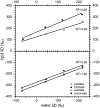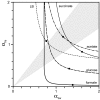Large D/H variations in bacterial lipids reflect central metabolic pathways
- PMID: 19617564
- PMCID: PMC2722351
- DOI: 10.1073/pnas.0903030106
Large D/H variations in bacterial lipids reflect central metabolic pathways
Abstract
Large hydrogen-isotopic (D/H) fractionations between lipids and growth water have been observed in most organisms studied to date. These fractionations are generally attributed to isotope effects in the biosynthesis of lipids, and are frequently assumed to be approximately constant for the purpose of reconstructing climatic variables. Here, we report D/H fractionations between lipids and water in 4 cultured members of the phylum Proteobacteria, and show that they can vary by up to 500 per thousand in a single organism. The variation cannot be attributed to lipid biosynthesis as there is no significant change in these pathways between cultures, nor can it be attributed to changing substrate D/H ratios. More importantly, lipid/water D/H fractionations vary systematically with metabolism: chemoautotrophic growth (approximately -200 to -400 per thousand), photoautotrophic growth (-150 to -250 per thousand), heterotrophic growth on sugars (0 to -150 per thousand), and heterotrophic growth on TCA-cycle precursors and intermediates (-50 to +200 per thousand) all yield different fractionations. We hypothesize that the D/H ratios of lipids are controlled largely by those of NADPH used for biosynthesis, rather than by isotope effects within the lipid biosynthetic pathway itself. Our results suggest that different central metabolic pathways yield NADPH--and indirectly lipids--with characteristic isotopic compositions. If so, lipid deltaD values could become an important biogeochemical tool for linking lipids to energy metabolism, and would yield information that is highly complementary to that provided by (13)C about pathways of carbon fixation.
Conflict of interest statement
The authors declare no conflict of interest.
Figures



Comment in
-
Isotopic remembrance of metabolism past.Proc Natl Acad Sci U S A. 2009 Aug 4;106(31):12565-6. doi: 10.1073/pnas.0906428106. Epub 2009 Jul 28. Proc Natl Acad Sci U S A. 2009. PMID: 19666618 Free PMC article. No abstract available.
Similar articles
-
2H/1H variation in microbial lipids is controlled by NADPH metabolism.Proc Natl Acad Sci U S A. 2019 Jun 18;116(25):12173-12182. doi: 10.1073/pnas.1818372116. Epub 2019 May 31. Proc Natl Acad Sci U S A. 2019. PMID: 31152138 Free PMC article.
-
Comparison of the effect of salinity on the D/H ratio of fatty acids of heterotrophic and photoautotrophic microorganisms.FEMS Microbiol Lett. 2015 May;362(10):fnv065. doi: 10.1093/femsle/fnv065. Epub 2015 Apr 15. FEMS Microbiol Lett. 2015. PMID: 25883110
-
Minimal Influence of [NiFe] Hydrogenase on Hydrogen Isotope Fractionation in H2-Oxidizing Cupriavidus necator.Front Microbiol. 2017 Oct 4;8:1886. doi: 10.3389/fmicb.2017.01886. eCollection 2017. Front Microbiol. 2017. PMID: 29085342 Free PMC article.
-
Allocate carbon for a reason: priorities are reflected in the ¹³C/¹²C ratios of plant lipids synthesized via three independent biosynthetic pathways.Phytochemistry. 2015 Mar;111:14-20. doi: 10.1016/j.phytochem.2014.12.005. Epub 2015 Jan 6. Phytochemistry. 2015. PMID: 25576502 Review.
-
Cometary deuterium.Space Sci Rev. 1999;1-2:33-43. doi: 10.1007/978-94-011-4211-3_3. Space Sci Rev. 1999. PMID: 11543290 Review.
Cited by
-
Optical photothermal infrared spectroscopy: A novel solution for rapid identification of antimicrobial resistance at the single-cell level via deuterium isotope labeling.Front Microbiol. 2023 Feb 1;14:1077106. doi: 10.3389/fmicb.2023.1077106. eCollection 2023. Front Microbiol. 2023. PMID: 36819022 Free PMC article.
-
Deuterium in marine organic biomarkers: toward a new tool for quantifying aquatic mixotrophy.New Phytol. 2022 May;234(3):776-782. doi: 10.1111/nph.18023. Epub 2022 Mar 4. New Phytol. 2022. PMID: 35133656 Free PMC article.
-
Large enrichments in fatty acid 2H/1H ratios distinguish respiration from aerobic fermentation in yeast Saccharomyces cerevisiae.Proc Natl Acad Sci U S A. 2024 May 14;121(20):e2310771121. doi: 10.1073/pnas.2310771121. Epub 2024 May 6. Proc Natl Acad Sci U S A. 2024. PMID: 38709917 Free PMC article.
-
Fractionation of Hydrogen Isotopes by Sulfate- and Nitrate-Reducing Bacteria.Front Microbiol. 2016 Aug 2;7:1166. doi: 10.3389/fmicb.2016.01166. eCollection 2016. Front Microbiol. 2016. PMID: 27531993 Free PMC article.
-
Near-threshold H/D exchange in CD₃CHO photodissociation.Nat Chem. 2011 Jun;3(6):443-8. doi: 10.1038/nchem.1052. Nat Chem. 2011. PMID: 21602858
References
-
- Robins RJ, et al. Measurement of 2H distribution in natural products by quantitative 2H NMR: An approach to understanding metabolism and enzyme mechanism? Phytochem Rev. 2003;2:87.
-
- Billault I, Guiet S, Mabon F, Robins RJ. Natural deuterium distribution in long-chain fatty acids is nonstatistical: A site-specific study by quantitative 2H NMR spectroscopy. ChemBioChem. 2001;2:425–431. - PubMed
-
- Krull E, Sachse D, Mügler I, Thiele A, Gleixner G. Compound-specific δ13C and δ2H analyses of plant and soil organic matter: A preliminary assessment of the effects of vegetation change on ecosystem hydrology. Soil Biol Biochem. 2006;38:3211–3221.
-
- Pond KL, Huang Y, Wang Y, Kulpa CF. Hydrogen isotopic composition of individual n-alkanes as an intrinsic tracer for bioremediation and source identification of petroleum contamination. Environ Sci Technol. 2002;36:724–728. - PubMed
-
- Sauer PE, Eglinton TI, Hayes JM, Schimmelmann A, Sessions AL. Compound specific D/H ratios of lipid biomarkers from sediments as a proxy for environmental and climatic conditions. Geochim Cosmochim Acta. 2001;65:213–222.
Publication types
MeSH terms
Substances
LinkOut - more resources
Full Text Sources

